Emergency savings fund growth strategies for financial security

Anúncios
Emergency savings fund growth strategies involve setting specific savings goals, choosing the right accounts, and considering investments to enhance financial security during unforeseen situations.
Emergency savings fund growth strategies are essential for anyone looking to build a financial safety net. Have you ever wondered how a solid emergency fund can transform your financial stability? Let’s dive into effective strategies that can help you enhance your savings.
Anúncios
Understanding the importance of an emergency savings fund
Having an emergency savings fund is essential for everyone’s financial health. It acts as a safety net, providing support during unexpected times. Imagine losing your job or facing sudden medical expenses without a backup plan; that’s where emergency savings come in.
One of the first steps in building your savings is understanding its value. It is crucial to have a specific amount set aside that can cover at least three to six months of living expenses. This ensures that, even in tough times, you can still manage your necessary bills.
The role of an emergency fund
An emergency fund serves multiple purposes. First, it provides peace of mind. Knowing you have funds to handle unexpected expenses allows you to feel secure. Second, it prevents you from relying on credit cards or loans, reducing your long-term debt.
- Covers unexpected medical costs
- Helps with car repairs or home maintenance
- Provides security during job loss
- Prevents financial stress
Additionally, building an emergency savings fund enhances your ability to make better financial decisions. Without the pressure of immediate expenses, you can evaluate your options more clearly.
Anúncios
Creating a separate account for your emergency fund can help you see your progress. This physical separation often makes it easier to refrain from using these funds for non-emergencies. Each time you add to this fund, you are investing in your future stability.
Strategies to grow your emergency fund
Starting small is okay. Even setting aside $20 a week can lead to significant savings over time. Gradually, as your financial situation improves, you can increase your contributions.
- Set realistic savings goals
- Automate your savings
- Cut down on unnecessary expenses
- Consider side jobs for extra income
In summary, having an emergency savings fund is not just about being prepared; it’s about building a stable financial future. By understanding its importance, you empower yourself to handle life’s surprises confidently.
Ways to effectively grow your emergency fund
Growing your emergency fund effectively is crucial for achieving financial security. With the right strategies, you can enhance your savings and have peace of mind during unexpected situations. Start by establishing clear goals for how much you want to save.
Set a savings target
Determine how much you want to have in your emergency fund. A common recommendation is to save at least three to six months’ worth of living expenses. This amount can help cover rent, groceries, and other necessities during difficult times.
- Analyze your monthly expenses
- Decide on a specific savings goal
- Break down the total amount into manageable monthly targets
Another effective way to grow your fund is by automating your savings. Setting up automatic transfers from your checking to your savings account ensures that you consistently contribute without even thinking about it.
Make saving a habit
Developing a saving habit is essential. Try to treat your savings like a regular expense. Dedicate a portion of your income to your emergency fund every month, just like you would for rent or utilities.
- Start with a small percentage of your income
- Gradually increase the amount as you become comfortable
- Stay committed to your savings routine
Additionally, consider cutting back on some non-essential expenses. Evaluate your monthly spending, and identify areas where you can save. For instance, dining out less frequently or canceling unused subscriptions can free up more funds for your emergency savings.
Lastly, explore ways to earn extra income. Whether through a part-time job, freelance work, or selling unused items, putting that money directly into your emergency fund can help it grow faster. Every little bit adds up!
Best savings accounts for emergency funds

Choosing the right savings account for your emergency fund is crucial for maximizing its growth. Not all savings accounts offer the same benefits, so it’s important to compare your options. You want an account that provides good interest rates and easy access to your funds.
High-yield savings accounts
A high-yield savings account often offers better interest rates than traditional savings accounts. This means your money will grow faster. Look for accounts with no monthly fees to ensure your funds aren’t diminished unnecessarily.
- Compare interest rates from different banks
- Check for minimum balance requirements
- Ensure the account is insured by the FDIC
Another great option is an online savings account. Many online banks provide competitive rates because they have lower overhead costs compared to brick-and-mortar banks. Opening an online savings account can be simple and quick.
Money market accounts
Money market accounts combine features of savings and checking accounts, often offering higher interest rates. They typically require a higher minimum balance but can provide easy access to your money through checks or debit cards.
- Good for larger emergency funds
- Offers check-writing capabilities
- Usually provides higher interest rates than standard savings accounts
Before choosing an account, also consider the fees. Some accounts charge monthly maintenance fees or transaction fees. These can eat into your savings, so finding an account with minimal or no fees is essential.
Finally, regularly review your savings account. As interest rates change, it may be beneficial to switch to a better account over time. Keeping an eye on your options will help ensure your emergency fund continues to grow effectively.
Investing options for your savings growth
If you’re looking to grow your emergency savings, considering investing options can be a smart move. While keeping your funds in a savings account is safe, investing can potentially yield higher returns over time. This can help your emergency fund grow more effectively.
Stocks and ETFs
Investing in stocks or exchange-traded funds (ETFs) allows you to purchase a small piece of a company. This option often provides higher returns, especially over the long term. However, it comes with increased risk. Historically, stocks have outperformed savings accounts but can fluctuate significantly.
- Choose stocks from stable companies
- Consider diversified ETFs to spread risk
- Review your investments periodically
Another option is bonds. Bonds are generally considered safer than stocks because they provide fixed interest over time. They are a good choice for conservative investors looking to balance risk while still growing their funds.
Robo-advisors
Robo-advisors are online platforms that automatically manage investments for you. They create a personalized portfolio based on your risk tolerance and financial goals. This is a great way for beginners to enter the investing world without having to manage every detail themselves.
- Research popular robo-advisors
- Look for low fees and reasonable minimum investments
- Ensure they offer automated rebalancing
Consider mutual funds as well. These funds pool money from many investors to buy a diversified portfolio of stocks and bonds. This diversification can reduce overall risk and provide the potential for steady returns.
Finally, always assess your risk tolerance. If you are saving for emergencies, you may want to keep a portion of your funds in more secure investments. Balancing your savings and investments thoughtfully can lead to greater financial security.
Setting realistic savings goals
Setting realistic savings goals is foundational for building your emergency fund. When your goals are achievable, you’re more likely to stay motivated and reach them. Start by determining what you want to save for and how much you need.
Define specific goals
Specific goals make it easier to keep track of your progress. Instead of saying, “I want to save money,” try setting a goal like, “I want to save $1,500 for my emergency fund by the end of the year.” This clarity helps you plan better.
- Break down larger goals into smaller milestones
- Set a timeline for each goal
- Regularly review your progress
Next, consider your financial situation. An honest assessment of your income, expenses, and current savings will help you determine how much you can realistically save each month. It’s important to create a budget that allocates a specific amount for savings without compromising your essential needs.
Make your goals measurable
Measuring your goals can help you stay on track. This could involve tracking how much you save monthly or how close you are to reaching your total goal. Tools like budgeting apps or simple spreadsheets can help you visualize your progress.
- Use apps to set reminders for saving
- Create a savings chart to visualize growth
- Adjust your goals as needed
Also, be flexible. Sometimes life can throw unexpected expenses your way. If you find that you cannot meet your savings goals, don’t be discouraged. Instead, reevaluate and adjust your goals to suit your current situation. Saving is a journey, and it’s okay to adapt as you go.
Finally, celebrate milestones along the way! Whether it’s reaching a certain savings threshold or consistently saving for months, recognizing your achievements can motivate you to continue.
FAQ – Frequently Asked Questions About Emergency Savings Funds
Why is an emergency savings fund important?
An emergency savings fund is crucial because it provides financial security during unexpected situations like job loss or medical emergencies.
How much should I save in my emergency fund?
Ideally, you should aim to save three to six months’ worth of living expenses to cover essential costs during emergencies.
What are realistic goals for saving money?
Realistic savings goals are specific targets that are achievable within a set timeframe, helping you maintain motivation and track progress.
What types of accounts are best for emergency savings?
High-yield savings accounts, money market accounts, and online savings accounts are great options for growing your emergency fund securely.